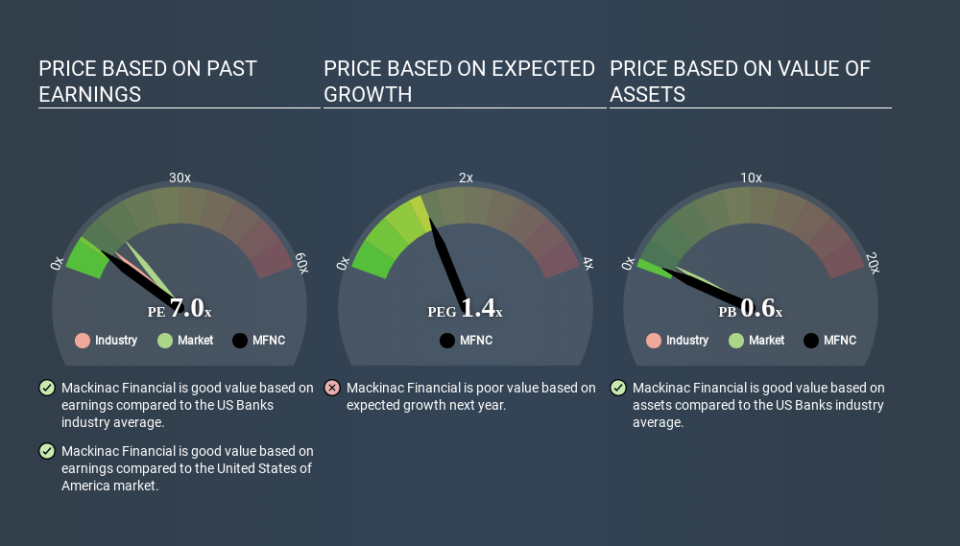What Is Mackinac Financial's (NASDAQ:MFNC) P/E Ratio After Its Share Price Tanked?

To the annoyance of some shareholders, Mackinac Financial (NASDAQ:MFNC) shares are down a considerable 39% in the last month. Indeed the recent decline has arguably caused some bitterness for shareholders who have held through the 43% drop over twelve months.
Assuming nothing else has changed, a lower share price makes a stock more attractive to potential buyers. While the market sentiment towards a stock is very changeable, in the long run, the share price will tend to move in the same direction as earnings per share. So, on certain occasions, long term focussed investors try to take advantage of pessimistic expectations to buy shares at a better price. One way to gauge market expectations of a stock is to look at its Price to Earnings Ratio (PE Ratio). A high P/E ratio means that investors have a high expectation about future growth, while a low P/E ratio means they have low expectations about future growth.
Check out our latest analysis for Mackinac Financial
Does Mackinac Financial Have A Relatively High Or Low P/E For Its Industry?
Mackinac Financial's P/E of 6.95 indicates relatively low sentiment towards the stock. If you look at the image below, you can see Mackinac Financial has a lower P/E than the average (8.9) in the banks industry classification.
Its relatively low P/E ratio indicates that Mackinac Financial shareholders think it will struggle to do as well as other companies in its industry classification. Since the market seems unimpressed with Mackinac Financial, it's quite possible it could surprise on the upside. If you consider the stock interesting, further research is recommended. For example, I often monitor director buying and selling.
How Growth Rates Impact P/E Ratios
P/E ratios primarily reflect market expectations around earnings growth rates. Earnings growth means that in the future the 'E' will be higher. Therefore, even if you pay a high multiple of earnings now, that multiple will become lower in the future. A lower P/E should indicate the stock is cheap relative to others -- and that may attract buyers.
Notably, Mackinac Financial grew EPS by a whopping 37% in the last year. And it has bolstered its earnings per share by 34% per year over the last five years. I'd therefore be a little surprised if its P/E ratio was not relatively high.
Remember: P/E Ratios Don't Consider The Balance Sheet
The 'Price' in P/E reflects the market capitalization of the company. So it won't reflect the advantage of cash, or disadvantage of debt. In theory, a company can lower its future P/E ratio by using cash or debt to invest in growth.
Spending on growth might be good or bad a few years later, but the point is that the P/E ratio does not account for the option (or lack thereof).
Is Debt Impacting Mackinac Financial's P/E?
Net debt is 44% of Mackinac Financial's market cap. While that's enough to warrant consideration, it doesn't really concern us.
The Bottom Line On Mackinac Financial's P/E Ratio
Mackinac Financial trades on a P/E ratio of 7.0, which is below the US market average of 13.0. The company does have a little debt, and EPS growth was good last year. The low P/E ratio suggests current market expectations are muted, implying these levels of growth will not continue. Given Mackinac Financial's P/E ratio has declined from 11.4 to 7.0 in the last month, we know for sure that the market is more worried about the business today, than it was back then. For those who prefer to invest with the flow of momentum, that might be a bad sign, but for deep value investors this stock might justify some research.
Investors have an opportunity when market expectations about a stock are wrong. As value investor Benjamin Graham famously said, 'In the short run, the market is a voting machine but in the long run, it is a weighing machine. So this free report on the analyst consensus forecasts could help you make a master move on this stock.
Of course you might be able to find a better stock than Mackinac Financial. So you may wish to see this free collection of other companies that have grown earnings strongly.
If you spot an error that warrants correction, please contact the editor at editorial-team@simplywallst.com. This article by Simply Wall St is general in nature. It does not constitute a recommendation to buy or sell any stock, and does not take account of your objectives, or your financial situation. Simply Wall St has no position in the stocks mentioned.
We aim to bring you long-term focused research analysis driven by fundamental data. Note that our analysis may not factor in the latest price-sensitive company announcements or qualitative material. Thank you for reading.

